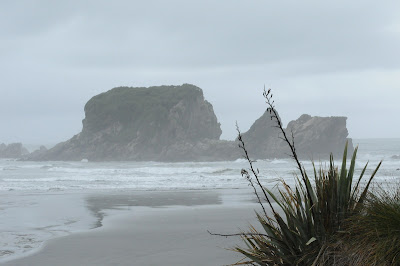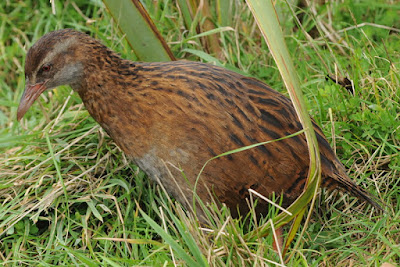Kerry-Jayne Wilson lives in a magnificent spot. From her sitting room you can look out to the waters of the Tasman Sea...
Or, by turning around, you can look across the coastal plain to the distant ridge of the Southern Alps.
Kerry-Jayne is a noted New Zealand ornithologist, author of Flight of the Huia,a detailed history of faunal change in the islands, and a friend of Eileen's since her visit to Sarawak some years ago. From March 3-7, she was also our host and guide to the wild west coast of the South Island, where you can still get a taste of what New Zealand must have been like before agriculture, forestry and settlement tamed and reduced it.
Not least of the West Coast pleasures are the magnificent seascapes. On our first days with her, Kerry-Jayne took us to a pair of remarkable spots. Here are two views of the first - the nature reserve at the Cape Foulwind, named by Captain Cook after a particularly unpleasant encounter with the local weather (though Abel Tasman was the first Western explorer to see it, on 14 December 1642).
Cape Foulwind's chief attraction other than the scenery - as the interpretative sign makes clear - is its colony of Southern (or Australian, or New Zealand) fur seals (Arctocephalus forsteri).
Wildlife watching, however, can start in the parking lot. New Zealand has three species of gull; this is the commonest and most widespread of them, the Red-billed Gull (Chroicocephalus scopulinus). The bird at the top is an immature; the lower photo shows what I presume is a full adult, though in high breeding colour the bill should be entirely red. We were there, of course, in the off season.
A short boardwalk trail through the cliffside vegetation led us to the fur seal colony...
..past more stunning cliffside scenery, dotted with clumps of New Zealand flax (Phormium cookianum).
This is one of the hardier coastal ferns, shore spleenwort (Asplenium obtusatum). It is quite tolerant of the salt spray that must drench it on a daily basis.
Below us, trailing strands of big bull kelp (Durvillaea antarctica) swept back and forth with the incoming waves.
On the trail we had a chance to get on close terms with one of New Zealand's distinctive, and increasingly rare, birds. The Weka (Gallirallus australis) is a flightless rail, an oversized relative of the widespread Buff-banded Rail (G. philippensis) of the southwest Pacific. Wekas are bold and inquisitive, and utterly unafraid of people. Until recently, they appeared to be holding their own in many parts of New Zealand. Now, however, they have vanished from much of their range, and the west country is one of their few remaining strongholds. There are four subspecies; this one is the nominate race, the Western Weka G. a. australis.
Here is some video of a Weka in action.
 By the time of our visit in March, the male fur seals had returned to the sea, leaving only females and still-nursing young stretched out on the rocks below.
By the time of our visit in March, the male fur seals had returned to the sea, leaving only females and still-nursing young stretched out on the rocks below.
The next day Kerry-Jayne took us to another coastal viewpoint, this time to see the famous "pancake rock" formations at Punakaiki. The entranceway features a grove of New Zealand's only native palm (and the most southerly palm in the world), the peculiar-looking nikau (Rhopalostylis sapida).
A nikau looks like nothing so much as a gigantic feather duster.
Unlike the granitic cliffs at Cape Foulwind, the rocks at Punakaiki are limestone - a series of hard limestone layers, separated from each other by a softer, easily-eroded mudstone.
The effect really does recall a stack of pancakes!
These peculiar formations were apparently created by stylobedding, a process in which the rocks were, basically, squashed flat under tremendous pressure followed by weathering of the mudstone layers.
The distinctive silhouette of a New Zealand cabbage tree (Cordyline australis) rises above the surrounding vegetation at Punakaiki.
Karamū (Coprosma lucida) was a valued medicinal plant for the Maoris.
Tutu (Coriaria arborea), on the other hand, is highly toxic. In the early days of European settlement it caused many livestock deaths,and it has has been responsible for poisoning circus elephants that ate it as they were being trouped around New Zealand. In one case, according to an online New Zealand encyclopedia, "Veterinarian David Marshall recalled that three elephants, poisoned (but not fatally) while travelling through the tutu-infested Buller Gorge, produced spectacular waist-high piles of vomit."
And with that delightful image in mind, I shall leave you to contemplate the seaside scenery!
Not least of the West Coast pleasures are the magnificent seascapes. On our first days with her, Kerry-Jayne took us to a pair of remarkable spots. Here are two views of the first - the nature reserve at the Cape Foulwind, named by Captain Cook after a particularly unpleasant encounter with the local weather (though Abel Tasman was the first Western explorer to see it, on 14 December 1642).
Cape Foulwind's chief attraction other than the scenery - as the interpretative sign makes clear - is its colony of Southern (or Australian, or New Zealand) fur seals (Arctocephalus forsteri).
Wildlife watching, however, can start in the parking lot. New Zealand has three species of gull; this is the commonest and most widespread of them, the Red-billed Gull (Chroicocephalus scopulinus). The bird at the top is an immature; the lower photo shows what I presume is a full adult, though in high breeding colour the bill should be entirely red. We were there, of course, in the off season.
A short boardwalk trail through the cliffside vegetation led us to the fur seal colony...
..past more stunning cliffside scenery, dotted with clumps of New Zealand flax (Phormium cookianum).
This is one of the hardier coastal ferns, shore spleenwort (Asplenium obtusatum). It is quite tolerant of the salt spray that must drench it on a daily basis.
Below us, trailing strands of big bull kelp (Durvillaea antarctica) swept back and forth with the incoming waves.

The next day Kerry-Jayne took us to another coastal viewpoint, this time to see the famous "pancake rock" formations at Punakaiki. The entranceway features a grove of New Zealand's only native palm (and the most southerly palm in the world), the peculiar-looking nikau (Rhopalostylis sapida).
A nikau looks like nothing so much as a gigantic feather duster.
Unlike the granitic cliffs at Cape Foulwind, the rocks at Punakaiki are limestone - a series of hard limestone layers, separated from each other by a softer, easily-eroded mudstone.
The effect really does recall a stack of pancakes!
These peculiar formations were apparently created by stylobedding, a process in which the rocks were, basically, squashed flat under tremendous pressure followed by weathering of the mudstone layers.
The distinctive silhouette of a New Zealand cabbage tree (Cordyline australis) rises above the surrounding vegetation at Punakaiki.
Karamū (Coprosma lucida) was a valued medicinal plant for the Maoris.
Tutu (Coriaria arborea), on the other hand, is highly toxic. In the early days of European settlement it caused many livestock deaths,and it has has been responsible for poisoning circus elephants that ate it as they were being trouped around New Zealand. In one case, according to an online New Zealand encyclopedia, "Veterinarian David Marshall recalled that three elephants, poisoned (but not fatally) while travelling through the tutu-infested Buller Gorge, produced spectacular waist-high piles of vomit."




























